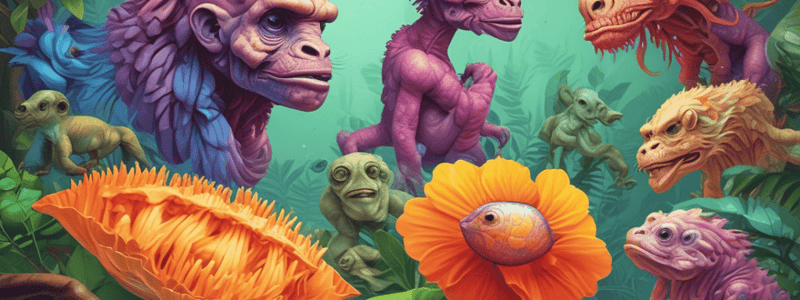Podcast
Questions and Answers
What are life history traits?
What are life history traits?
Life history traits include an organism’s age at first reproduction, the duration and schedule of reproduction, the number and size of offspring produced, and life span.
How do life history traits vary among different species?
How do life history traits vary among different species?
Short life, many eggs; Reproduce once in a short life; Long life, fewer offspring; Continually reproduce over a long life.
What do life history traits involve?
What do life history traits involve?
Life history traits involve trade-offs, as there is a limited amount of energy to invest in survival, maintenance, and reproduction.
What does natural selection aim to maximize in life history?
What does natural selection aim to maximize in life history?
How does the presence of predators influence life history traits?
How does the presence of predators influence life history traits?
What is a potential trade-off for living longer?
What is a potential trade-off for living longer?
How do life history strategies change over time?
How do life history strategies change over time?
What are some examples of life history traits?
What are some examples of life history traits?
How do offspring sex ratios of organisms like wasps (Hymenoptera) contribute to maximizing fitness?
How do offspring sex ratios of organisms like wasps (Hymenoptera) contribute to maximizing fitness?
According to the Trivers-Willard hypothesis, in what condition do mothers produce females?
According to the Trivers-Willard hypothesis, in what condition do mothers produce females?
When in good condition, what sex do mothers produce according to the Trivers-Willard hypothesis?
When in good condition, what sex do mothers produce according to the Trivers-Willard hypothesis?
Why do some organisms cannibalize eggs or offspring?
Why do some organisms cannibalize eggs or offspring?
How can females of certain species like sand gobies alter the sex ratios of their offspring?
How can females of certain species like sand gobies alter the sex ratios of their offspring?
What is the mechanism behind females altering the sex ratios of their offspring in species like fig wasps?
What is the mechanism behind females altering the sex ratios of their offspring in species like fig wasps?
How do females adjust the sex ratios of their offspring in species like thrips?
How do females adjust the sex ratios of their offspring in species like thrips?
What is the main benefit for organisms in regulating the number of offspring they produce?
What is the main benefit for organisms in regulating the number of offspring they produce?
What type of selection is described in the text?
What type of selection is described in the text?
Explain the advantage of being the rare sex in terms of mating opportunities.
Explain the advantage of being the rare sex in terms of mating opportunities.
What is genomic imprinting?
What is genomic imprinting?
What is the difference between mules and hinnies?
What is the difference between mules and hinnies?
Define epigenetics.
Define epigenetics.
What is the role of predation risk in driving life history evolution in guppies?
What is the role of predation risk in driving life history evolution in guppies?
What is the trade-off observed in guppies in predator-free streams for 11 years?
What is the trade-off observed in guppies in predator-free streams for 11 years?
How do anolis lizards demonstrate parental investment?
How do anolis lizards demonstrate parental investment?
In which species is there a sex role reversal where males provide parental care and females guard harems of males?
In which species is there a sex role reversal where males provide parental care and females guard harems of males?
What is the Operational Sex Ratio (OSR)?
What is the Operational Sex Ratio (OSR)?
Do you predict OSR to be male or female-biased in jacanas?
Do you predict OSR to be male or female-biased in jacanas?
What is the importance of mate choice in male pipefishes?
What is the importance of mate choice in male pipefishes?
What variation is observed in the number of mates between male and female pipefishes?
What variation is observed in the number of mates between male and female pipefishes?
What is a possible mechanism that is responsible for the difference in sex ratio adjustment between birds and mammals?
What is a possible mechanism that is responsible for the difference in sex ratio adjustment between birds and mammals?
Why do we predict that some species will switch sex in a 'Trivers-Willard-predicted' manner?
Why do we predict that some species will switch sex in a 'Trivers-Willard-predicted' manner?
What is the sex ratio adjustment mechanism observed in Bluestreak cleaner wrasse?
What is the sex ratio adjustment mechanism observed in Bluestreak cleaner wrasse?
In which species are sex ratios controlled by Wolbachia bacteria?
In which species are sex ratios controlled by Wolbachia bacteria?
What is the sex ratio adjustment mechanism where some females only have daughters and transmit genes from their mothers?
What is the sex ratio adjustment mechanism where some females only have daughters and transmit genes from their mothers?
What is paternal genome elimination?
What is paternal genome elimination?
Why are sex ratios often balanced?
Why are sex ratios often balanced?
What is one potential benefit of having daughters in species where females adjust the sex ratio based on resource availability?
What is one potential benefit of having daughters in species where females adjust the sex ratio based on resource availability?
Flashcards are hidden until you start studying




